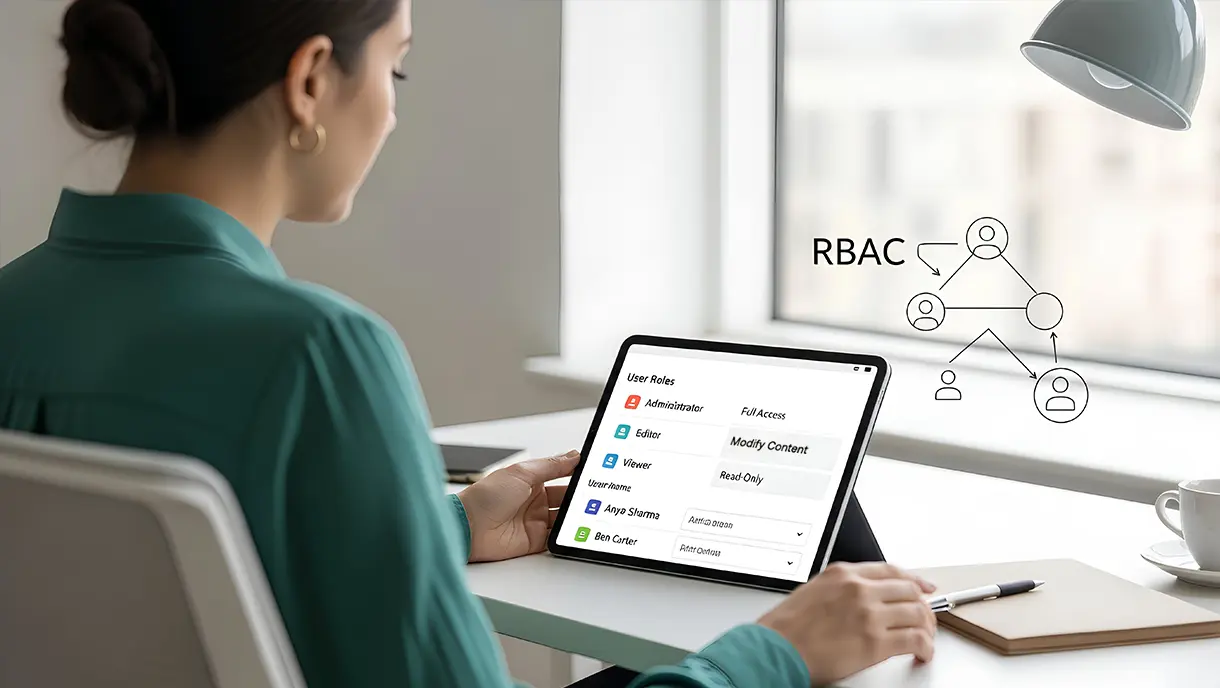Role-Based Access Control (RBAC): A Complete Guide for Secure Access Management
Role-Based Access Control (RBAC) has become the foundation of modern access management for organizations worldwide. RBAC simplifies security by assigning permissions based on job roles rather than individual users. This guide explains how RBAC strengthens data protection, streamlines user management, and supports compliance requirements. Learn practical implementation approaches, industry-specific applications, and strategies for overcoming common obstacles.

Managing access in a growing organization can get complicated fast. New apps get added, teams expand, roles change, and before you know it, permissions are scattered across systems with no clear structure.
That’s when security gaps appear, audits get stressful, and IT teams end up spending hours manually fixing access issues. Role-Based Access Control (RBAC) changes this.
Instead of assigning permissions user by user, RBAC lets you define roles that reflect how your organization actually works, then tie access to those roles. The result is cleaner access management, fewer mistakes, and a security model that scales as your business evolves.
This guide breaks down what RBAC is, why organizations rely on it, and how it helps solve common challenges like inconsistent permissions, compliance pressure, and the growing risk of unauthorized access.
What Is Role-Based Access Control (RBAC)?
Role-Based Access Control (RBAC) is a security model that organizes user access around defined roles within an organization. Instead of giving permissions to individuals one by one, RBAC assigns permissions to roles, and users receive access based on the role they belong to. This makes access management cleaner, more consistent, and easier to scale.
In an RBAC system, a role typically represents a job function or responsibility. For example, an HR manager, a sales representative, or a system administrator would each have specific roles. Each of these roles has predefined permissions that reflect what tasks the person in that position needs to perform. When a user is added to the role, they automatically inherit the correct level of access.
RBAC differs from other access control models in how it manages permissions and makes access decisions.
- Discretionary Access Control allows resource owners to grant access at their discretion, creating inconsistent security policies.
- Mandatory Access Control utilizes fixed security labels and clearances, which provide less flexibility in meeting business needs.
- Attribute-Based Access Control evaluates multiple dynamic attributes, such as user location, time, and device, to make decisions.
RBAC vs Other Access Control Models
Each access control model offers distinct advantages and suits different security requirements and organizational contexts. Here’s how RBAC compares to different models:
Many organizations adopt role-based access control (RBAC) for its strong balance of security, scalability, and ease of management. This model suits enterprises where job roles are clearly aligned with access privileges.
To learn more about how RBAC compares with Attribute-Based Access Control (ABAC), refer to our in-depth guide on the differences between RBAC and ABAC, which provides a comprehensive comparison of the two major access control models. Next, let’s explore the components of role-based access control.
Key Components Of Role-Based Access Control
RBAC consists of several fundamental elements that work together to create a comprehensive access control system. Each component plays a specific role in ensuring users receive appropriate access based on their organizational responsibilities.
1. Roles
Roles represent job functions or responsibilities within an organization and serve as the primary mechanism for granting access to resources and assets. Common examples include Administrator, Manager, Employee, Accountant, Developer, and Customer Service Representative.
Organizations design roles to match their actual structure, with some companies having dozens of roles while others maintain simpler structures. These roles may vary significantly by department, with HR roles differing from IT roles or sales roles. Effective role design requires analyzing job functions, understanding access requirements, and creating roles that align with business processes.
2. Permissions
Permissions define specific actions users can perform on resources, such as read, write, modify, delete, or execute. Organizations map permissions to roles by determining what access each job function requires to perform duties.
A Manager role might include permissions to view employee records, approve requests, and generate reports. An Employee role might have permissions limited to viewing their own information and submitting requests. Permission design requires balancing operational needs with security principles, ensuring roles have sufficient access without excessive privileges.
3. Users And Role Assignments
Users are individuals who access systems and resources within the organization's environment. Each user receives role assignments that determine their access rights based on job responsibilities. Users can be assigned to multiple roles simultaneously when their position requires diverse access needs.
Organizations must conduct regular role reviews to ensure assignments remain appropriate as employees change positions. Periodic access reviews help identify and remove unnecessary role assignments that accumulate over time. This ongoing management prevents permission creep and maintains security posture.
4. Sessions And Constraints
Sessions represent active periods when users access systems using their assigned roles. Organizations can implement constraints that restrict role activation based on contextual factors, such as time or location. Temporary role assignments grant elevated access for specific projects with automatic expiration dates.
Time-based constraints may limit access to the financial system during business hours when oversight is available. Location restrictions might prevent role activation from untrusted networks or unauthorized geographic regions. Device-based constraints ensure users activate sensitive roles only from managed, secure endpoints.
Together, these components form the foundation of an RBAC system and define how users, roles, and permissions fit together. Now that the building blocks are clear, the next step is understanding how RBAC actually works in practice and how these components interact during day-to-day access management.
How Role-Based Access Control Works
RBAC operates through a systematic process that connects users, roles, and permissions to control access to resources. The process ensures consistent access control while simplifying management and supporting compliance requirements.
1. User Assignment to Roles
Organizations assign each user to one or more roles based on their job function and responsibilities. Roles reflect actual positions within the organization, such as Manager, Analyst, or Administrator.
Users automatically inherit all permissions associated with their assigned roles without individual permission configuration. This assignment process typically occurs during onboarding and updates when employees change positions or departments.
2. Roles Are Linked to Permissions
Each role is configured with specific permissions that define what actions users can perform. Permissions specify access to resources, such as files, applications, databases, or system functions.
Businesses map permissions to roles by analyzing job requirements and security policies to ensure effective role-based access control. This mapping ensures that users can perform their duties while maintaining the principle of least privilege access.
3. Access Is Granted Through Roles, Not Individuals
When users attempt to access resources, the system evaluates their roles to determine the permissions to which they are entitled. Access decisions are based on role memberships rather than individual user identities or attributes.
This approach simplifies access management because permission changes apply to roles rather than individual users. Organizations can modify access for entire groups by updating role permissions, rather than individual accounts.
4. Role Hierarchies and Inheritance
Many organizations implement role hierarchies in which senior roles automatically inherit permissions from junior roles. A Manager role might inherit all Employee permissions plus additional management capabilities.
These hierarchies reflect organizational reporting structures and reduce redundant permission assignments. Role inheritance simplifies administration while ensuring consistency across related roles in the organization.
5. Session Management and Constraints
RBAC systems can enforce constraints that limit when and how users activate their roles. Time-based restrictions restrict access to business hours or specific days of the week. Location constraints ensure users access resources only from approved networks or geographic regions.
These session controls add contextual security layers that adapt to risk profiles and compliance requirements.
6. Auditing and Monitoring
RBAC systems maintain detailed logs of role assignments, permission changes, and access attempts. These audit trails document who accessed what resources, when access occurred, and which role authorized it.
Companies utilize this information for security investigations, compliance reporting, and refining access policies. Regular monitoring helps identify potential security issues, such as excessive permissions or unusual access patterns.
7. Dynamic Updates and Role Changes
Organizations regularly review and update roles to reflect changing business needs and security requirements. When employees change positions, administrators reassign them to appropriate roles rather than modifying individual permissions.
Role permission updates are automatically applied to all assigned users, ensuring consistent enforcement of the policy. This dynamic capability enables businesses to maintain security while supporting business agility and organizational change.
When you see how users, roles, and permissions come together in real time, it becomes clear why RBAC is such a practical and dependable model for managing access. With the mechanics in place, the next question is why RBAC matters for modern organizations and what makes it a preferred approach for security and compliance today.
[[cta]]
Importance Of RBAC In Modern Organizations
RBAC has become essential for organizations managing complex IT environments and regulatory requirements. The model delivers strategic advantages that extend beyond basic access control to support business objectives.
1. Enhances Security And Minimizes Risk
RBAC enhances security by implementing the principle of least privilege and minimizing opportunities for unauthorized access. Users receive only the permissions necessary for their specific job functions and responsibilities. This approach significantly limits the potential damage from compromised accounts or insider threats.
- Prevents unauthorized access to sensitive systems and data by enforcing role-based boundaries.
- Reduces insider threat risk by limiting access to only what users need for their specific job roles.
- Automatically implements least privilege principles through well-designed role structures.
- Enforces separation of duties by preventing conflicting permission combinations in single roles.
- Minimizes attack surface by reducing the number of users with elevated privileges.
2. Ensures Compliance With Regulations
RBAC supports compliance with data protection and industry-specific regulations by implementing structured access controls. Organizations can demonstrate clear access policies and enforcement mechanisms required by regulatory frameworks. The model simplifies compliance audits by providing documented role structures and permission mappings.
- Supports GDPR requirements for access controls and data protection by design.
- Enables HIPAA compliance through role-based access restrictions to patient data.
- Facilitates SOX compliance by enforcing segregation of duties in financial systems.
- Simplifies audit processes by providing clear documentation of who can access which resources.
- Provides detailed audit trails that show role assignments and permission usage for regulatory reporting purposes.
3. Streamlines Operational Efficiency
RBAC dramatically reduces the administrative burden of managing user access across growing organizations. IT teams spend less time on individual permission assignments and more on strategic initiatives. The model accelerates standard processes, such as onboarding, role changes, and offboarding, significantly.
- Reduces IT helpdesk workload by eliminating individual permission requests and troubleshooting.
- Accelerates employee onboarding by assigning predetermined roles instead of configuring individual permissions.
- Simplifies role changes when employees transfer to new positions or departments.
- Streamlines offboarding by removing role assignments rather than individual permissions.
- Enables delegation of role assignment to department managers without exposing permission details.
4. Supports Organizational Scalability
RBAC scales efficiently as organizations grow and add new systems, users, and resources. The model accommodates new roles and permission requirements without requiring a redesign of the entire access control structure. Companies can expand operations while maintaining consistent security policies and manageable administrative overhead.
- Manages access across growing teams without proportionally increasing administrative effort.
- Accommodates new departments and business units by creating appropriate role structures.
- Integrates new systems and applications by mapping roles to new permissions and privileges.
- Supports mergers and acquisitions by incorporating acquired company roles into existing structures.
- Maintains consistent security policies across distributed locations and the remote workforce.
5. Facilitates Better Accountability
RBAC creates clear accountability by linking access activities to specific organizational roles. Organizations can track which roles accessed sensitive resources and when access occurred. This visibility supports security investigations and helps identify potential policy violations or suspicious activities.
- Tracks user actions by associating activities with roles rather than individual identities.
- Creates comprehensive audit trails for security investigations and compliance reporting.
- Enables role-based reporting that identifies which job functions have access to sensitive resources.
- Supports forensic analysis by providing clear records of role assignments and permission usage.
- Facilitates the assignment of responsibility for security incidents based on role access patterns.
Understanding why RBAC matters highlights just how valuable it can be for security, compliance, and operational efficiency. To see its impact more clearly, the next section explores real-world use cases and examples of how organizations apply RBAC in everyday scenarios.
[[cta-2]]
RBAC Use Cases And Examples
Organizations across industries leverage RBAC to address specific access management challenges and security requirements. These real-world applications demonstrate how RBAC adapts to diverse business environments and regulatory contexts.
1. RBAC In Enterprise IT Systems
Enterprise IT departments use RBAC to control access to internal applications, cloud resources, and infrastructure. System administrators receive elevated permissions to manage servers and networks, while regular employees access only business applications. Developers get access to development environments but not production systems without approval processes.
- Network administrators manage routers, switches, and security appliances through elevated roles and responsibilities.
- Database administrators access production databases while developers use sandboxed environments.
- Helpdesk staff receive limited permissions to reset passwords and troubleshoot common issues.
- Application owners control their specific systems without accessing unrelated infrastructure.
2. RBAC In Healthcare
The healthcare industry implements RBAC to protect patient information while enabling efficient care delivery. Physicians access patient records for assigned patients, while administrative staff manage billing and scheduling. RBAC helps healthcare providers comply with HIPAA requirements for access controls and audit trails.
- Doctors and nurses access patient records based on current care team assignments.
- Pharmacists view medication information and prescription histories for verification.
- Billing staff access insurance and payment information without viewing clinical details.
- Administrative personnel manage schedules and appointments without accessing medical records.
- Emergency staff receive break-glass access for urgent situations, accompanied by audit trail documentation.
3. RBAC In Financial Services
Financial institutions use RBAC to enforce segregation of duties and prevent fraud. Trading roles avoid the same person from initiating and approving transactions. Audit roles provide read-only access to detect suspicious activities without modification capabilities.
- Traders execute transactions while compliance officers review and approve large trades.
- Accountants record transactions while auditors review financial records independently.
- Customer service representatives access account information without transfer capabilities.
- Risk managers analyze data across accounts without the ability to modify customer information.
- Branch managers approve transactions within authority limits defined by their role.
4. RBAC In Cloud And SaaS Applications
Cloud platforms and SaaS applications use RBAC to manage multi-tenant environments and subscription tiers. Organizations control access to cloud resources based on department, project, or cost center. SaaS platforms implement role-based feature access to support different subscription levels and user types.
- Cloud platform administrators manage infrastructure while developers deploy applications.
- Project managers have full access to project management tools, while team members have limited capabilities.
- Tenant administrators manage their organization's users without accessing other tenants.
- Subscription tiers map to roles that enable or restrict access to premium features.
- API access roles control which systems can integrate with SaaS platforms programmatically.
These use cases show how RBAC can support different teams, workflows, and security requirements across an organization. As you move toward implementing RBAC yourself, it is important to understand the challenges that can arise and the practical ways to address them. The next section covers exactly that.
[[cta-3]]
Common RBAC Implementation Challenges And How To Overcome Them
Organizations implementing RBAC often encounter obstacles that can undermine their effectiveness if not addressed appropriately. The following sections outline the most common RBAC problems and practical approaches for resolving them.
1. Role Explosion
Role explosion occurs when organizations create too many specialized roles to accommodate minor variations in permissions and responsibilities. This proliferation makes RBAC as complex as managing individual permissions, thereby defeating the model's purpose of simplification.
Businesses struggle to maintain, audit, and govern hundreds or thousands of narrowly defined roles. Role explosion typically results from creating unique roles for every slight permission difference rather than grouping similar requirements.
How to Overcome This Challenge
- Consolidate similar roles by identifying common permission patterns across job functions.
- Use role hierarchies to handle permission variations through inheritance rather than separate roles.
- Implement attribute-based constraints on top of RBAC for contextual access without creating new roles.
- Establish governance for role creation that requires business justification and approval processes to ensure effective management.
- Regularly review and retire unnecessary roles that duplicate or overlap with existing ones.
- Set a target for the maximum role count based on the organization's size and complexity.
2. Misconfigured Permissions
Misconfigured permissions occur when roles receive inappropriate access levels, either too restrictive or too permissive. Overly restrictive roles prevent users from performing legitimate job duties, frustrating employees and reducing productivity.
Excessive permissions violate the principle of least privilege, creating security risks by granting unnecessary access. Misconfigurations often result from unclear role requirements or inadequate testing during the design process for the role.
How to Overcome This Challenge
- Document detailed permission requirements before creating or modifying roles.
- Test new roles with pilot users before broad deployment to identify missing or excessive permissions.
- Implement change control processes requiring approval for role permission modifications.
- Monitor access patterns to identify permissions that users never utilize.
- Conduct user surveys to identify permission gaps preventing work completion.
- Use automated tools to detect and alert on permission anomalies or security violations.
3. Risks of Improper Access
Improper access risks arise when users receive unnecessary permissions through poorly designed roles. Users may access sensitive data or perform actions beyond their legitimate responsibilities.
Excessive access increases the risk of insider threats and potential damage from compromised accounts.
How to Overcome This Challenge
- Implement regular access certification processes where managers review and approve employee permissions.
- Use automated tools to identify users with excessive permissions or risky permission combinations.
- Enforce separation of duties by preventing conflicting permissions within a single role.
- Remove inactive user accounts and stale role assignments that accumulate over time.
- Monitor access logs for unusual activities that may indicate role misuse or account compromise.
- Conduct periodic risk assessments to identify roles with potentially dangerous permission combinations.
4. Integration With Existing Systems
Legacy systems often lack native RBAC support, making integration challenging during RBAC deployments. Different systems may use incompatible role definitions or permission models requiring translation layers. Organizations struggle to maintain consistent role definitions across diverse technology platforms.
How to Overcome This Challenge
- Prioritize systems for RBAC integration based on security risk and business impact.
- Utilize identity and access management platforms that offer connectors for common applications.
- Implement role mapping layers that translate central roles to application-specific permissions.
- Consider modernizing or replacing legacy systems that cannot support adequate access controls.
- Use privileged access management tools to control elevated access to systems lacking RBAC.
- Document role mappings between systems to maintain consistency and support troubleshooting.
Move Beyond RBAC With OLOID’s Passwordless Authentication Platform
While RBAC remains a reliable way to organize permissions, many organizations are moving toward smarter and more adaptive access models. OLOID’s frontline passwordless authentication platform takes this a step further by removing passwords entirely and tying access to real identity instead of static roles.
OLOID helps eliminate credential-based risks, reduces administrative work, and creates a unified approach to securing both digital and physical systems. With OLOID, access becomes seamless and secure across apps, devices, and workplaces, giving you stronger protection than traditional RBAC alone.
If you are looking to modernize your access strategy and build a frictionless user experience, now is the time to explore what passwordless authentication can offer. Book a demo to see how OLOID can help you simplify access, strengthen security, and move beyond the limits of traditional RBAC.
FAQs on Role-Based Access Control
1. How does RBAC help prevent insider threats?
RBAC prevents insider threats by implementing the principle of least privilege and separating duties across roles. Users receive only the permissions necessary for their specific job functions, limiting potential damage from malicious insiders.
The model enforces separation of duties by preventing individuals from having conflicting permissions that could enable fraud. Regular access reviews and audit trails help identify unusual access patterns that may indicate insider threat activity.
2. Can RBAC protect sensitive data in my organization?
Yes, RBAC effectively protects sensitive data by controlling who can access, modify, or delete critical information. Organizations design roles that grant access to sensitive data only for positions requiring it for legitimate business purposes.
RBAC supports data classification by mapping different access levels to roles based on clearance and need-to-know principles. Combined with encryption and monitoring, RBAC creates comprehensive protection for sensitive organizational data.
3. How often should roles and permissions be reviewed to maintain security?
Organizations should conduct role and permission reviews at least quarterly, with more frequent reviews for high-risk environments. Access certification processes should occur at least annually, requiring managers to verify employee role assignments and ensure accuracy. Many compliance frameworks, such as SOX and PCI-DSS, need regular access reviews to maintain certification.
Permission audits should happen whenever roles are modified or when security incidents occur. Leading organizations conduct monthly reviews for privileged roles and systems that contain sensitive data. Regular reviews help identify and remove excessive permissions, ensuring that roles remain aligned with business requirements.
4. How is RBAC different from other security models in terms of risk management?
RBAC manages risk by organizing permissions around job functions rather than individual users or resource owners. Unlike Discretionary Access Control, RBAC prevents inconsistent access decisions by centralizing permission management.
RBAC offers more flexibility than Mandatory Access Control while maintaining stronger controls than discretionary approaches. The model strikes a better balance between security and usability than alternatives for most enterprise environments and use cases.
5. Can RBAC be integrated with multi-factor authentication for better security?
Yes, RBAC integrates seamlessly with multi-factor authentication to create layered security protection. Organizations can require MFA for roles with elevated privileges or sensitive data access.
MFA adds verification layers that complement RBAC's permission controls, strengthening protection against compromised credentials. Modern identity and access platforms support both RBAC and MFA, enabling organizations to implement comprehensive access security strategies.






Get the latest updates! Subscribe now!




